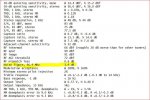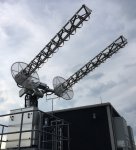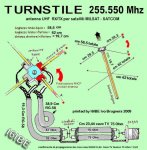prcguy
Member
The 20 to 60 deg range is based on typical satellite look angles within the Continental US (CONUS) and focusing as much omni directional gain at those angles as possible. The X-Wing does have gain but I'm attending the Dayton Hamvention this weekend and don't have my old files with me to look that up.
The design allows the antenna to sit on flat ground pointing straight up and be useable on as many UHF military satellite as possible within the US or places of similar Latitude above or below the equator such as parts of EU, South America, Australia. etc.
A preamp can help depending on receiver and length/type of feed line. I get great performance using about 20ft of RG-58 coax and a Yupiteru MVT-7100 receiver. YMMV.
The MT X-Wing is designed as a receive only antenna and would have high VSWR and degraded circular polarization in the uplink portion of the band.
prcguy
The design allows the antenna to sit on flat ground pointing straight up and be useable on as many UHF military satellite as possible within the US or places of similar Latitude above or below the equator such as parts of EU, South America, Australia. etc.
A preamp can help depending on receiver and length/type of feed line. I get great performance using about 20ft of RG-58 coax and a Yupiteru MVT-7100 receiver. YMMV.
The MT X-Wing is designed as a receive only antenna and would have high VSWR and degraded circular polarization in the uplink portion of the band.
prcguy
Hmmmm? That 20-60 degree range is what the Amsat folks claim is normal operation, especially with handheld antenna contacts.
I doubt that the X wing would have any gain, however. Would that be omni-directional too? Perhaps a preamp would help.
This is primarily a receive only antenna, Ever been used to transmit?










